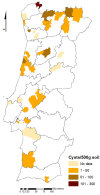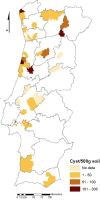Potato Cyst Nematodes: Geographical Distribution, Phylogenetic Relationships and Integrated Pest Management Outcomes in Portugal
- PMID: 33391317
- PMCID: PMC7773931
- DOI: 10.3389/fpls.2020.606178
Potato Cyst Nematodes: Geographical Distribution, Phylogenetic Relationships and Integrated Pest Management Outcomes in Portugal
Abstract
The identification and phylogenetic relationships of potato cyst nematodes (PCN) were studied to assess the potential value of geographical distribution information for integrated pest management of potato production in Portugal. This research focused on PCN species, Globodera pallida and Globodera rostochiensis. From 2013 until 2019, 748 soil samples from the rhizosphere of different potato cultivars were surveyed in the Portuguese mainland to detect and identify both species and track their location. PCN are widespread invasive species throughout Portugal. In fact, during the survey period an incidence of 22.5% was estimated for the tested samples. The patterns of infestation vary among regions, increasing from south to north, where PCN were first detected. Currently, both species are present in all potato producing regions of the country, with a greater incidence of G. pallida. Phytosanitary control measures are influencing to the observed results. The use of potato cultivars resistant to G. rostochiensis led to a decrease of this species but had no influence on G. pallida detections, which continues its reproduction freely since there are no effective resistant cultivars for this species. The relationship between the presence, infestation rate, spread and geographical distribution of PCN is discussed in terms of behavioral responses of the potato cultivars and the implications for developing new integrated crop protection measures.
Keywords: Globodera pallida; Globodera rostochiensis; Heteroderidae; Solanum tuberosum; disease.
Copyright © 2020 Camacho, de Andrade, Mota, Nobrega, Vicente, Rusinque and Inácio.
Conflict of interest statement
The authors declare that the research was conducted in the absence of any commercial or financial relationships that could be construed as a potential conflict of interest.
Figures




References
-
- Alptekin Y. (2011). Integrated pest management of potatoes. Agric. Sci. 2 297–300. 10.4236/as.2011.23039 - DOI
-
- Bulman S., Marshall J. (1997). Differentiation of Australasian potato cyst nematode (PCN) populations using the polymerase chain reaction (PCR). N. Z. J. Crop Hortic. Sci. 25 123–129. 10.1080/01140671.1997.9513998 - DOI
-
- Camacho M. J., Nóbrega F., Lima A., Mota M., Inácio M. L. (2017). Morphological and molecular identification of the potato cyst nematodes (Globodera rostochiensis and G. pallida) in Portuguese potato fields. Nematology 19 883–889. 10.1163/15685411-00003094 - DOI
-
- Christoforou M., Pantelides I. S., Kanetis L., Ioannou N., Tsaltas D. (2014). Rapid detection and quantification of viable potato cyst nematodes using qPCR in combination with propidium monoazide. Plant Pathol. 63 1185–1192. 10.1111/ppa.12193 - DOI
-
- Conceição I., Santos M., Abrantes I., Santos S. (2003). Using RAPD markers to analyse genetic diversity in Portuguese potato cyst nematode populations. Nematology 5 137–143. 10.1163/156854102765216759 - DOI
LinkOut - more resources
Full Text Sources

